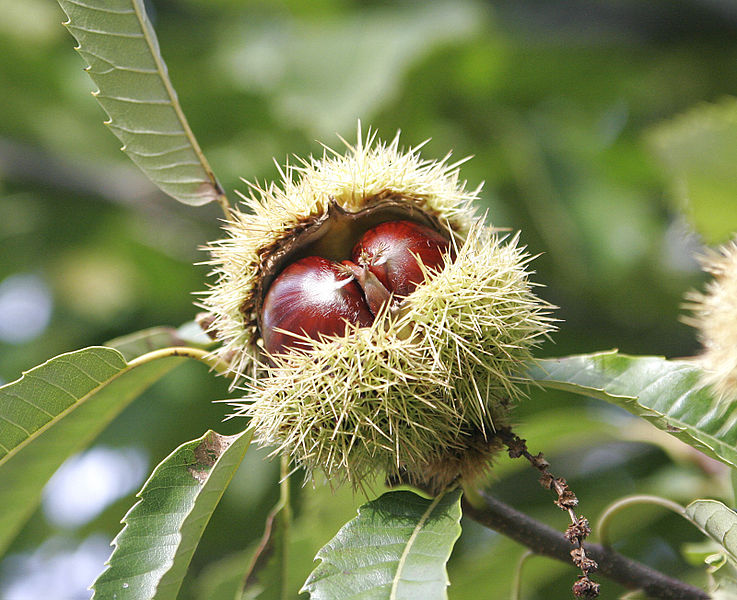![Inspired by traditional folk remedies, scientists create European chestnut extract with ability to shut down MRSA infections, [fir0002 | flagstaffotos.com.au, via Wikimedia Commons]](https://genengnews.com/wp-content/uploads/2018/08/737pxChestnuts1804512091-1.jpg)
Inspired by traditional folk remedies, scientists create European chestnut extract with ability to shut down MRSA infections, [fir0002 | flagstaffotos.com.au, via Wikimedia Commons]
In recent years, scientists have begun to take traditional herbal remedies and local folklore a bit more seriously—especially in the wake of skyrocketing rates of microbial drug resistance. Many traditional medicine treatments are being carefully dissected to isolate specific compounds of therapeutic value.
Now, researchers at Emory University have observed that extracts from the leaves of the European, or sweet chestnut tree (Castanea sativa), contain compounds with the ability to disarm pathogenic strains of Staphylococcus aureus. The researchers found that the leaf extract was rich in ursene and oleanene derivatives, which block microbial virulence without increasing resistance.
“We've identified a family of compounds from this plant that have an interesting medicinal mechanism,” explained Cassandra Quave, Ph.D., assistant professor of ethnobotany at Emory University. “Rather than killing staph, this botanical extract works by taking away staph's weapons, essentially shutting off the ability of the bacteria to create toxins that cause tissue damage. In other words, it takes the teeth out of the bacteria's bite.”
The findings from this study were published recently in PLOS ONE through an article entitled “Castanea sativa (European Chestnut) Leaf Extracts Rich in Ursene and Oleanene Derivatives Block Staphylococcus aureus Virulence and Pathogenesis without Detectable Resistance.”
Antibiotic-resistant bacteria are the cause of at least two million illnesses and 23,000 deaths annually within the U.S. Current tends show that resistance continues to rise with ever more “super bugs” like MRSA being identified more frequently.
“We've demonstrated in the lab that our extract disarms even the hyper-virulent MRSA strains capable of causing serious infections in healthy athletes,” Dr. Quave said. “At the same time, the extract doesn't disturb the normal, healthy bacteria on human skin. It's all about restoring balance.”
After hundreds of field interviews with rural peoples from southern Italy and other parts of the Mediterranean, Dr. Quave and her colleagues were pointed in the direction of European chestnut tree as a traditional medicinal source of cherished value.
“Local people and healers repeatedly told us how they would make a tea from the leaves of the chestnut tree and wash their skin with it to treat skin infections and inflammations,” Dr. Quave noted.
The Emory researchers steeped the chestnut leaves in a mixture of solvents to extract various classes of chemical compounds. They were able to produce an extract of 94 distinct chemicals, of which ursine and oleanene derivatives were the most active.
“You separate the complex mixture of chemicals found in the extract into smaller batches with fewer chemical ingredients, test the results, and keep honing in on the ingredients that are the most active,” Quave explains. “It's a methodical process and takes a lot of hours at the bench.”
The investigators were able to show that the extract inhibited the ability of staph bacteria to communicate with each other—a process known as quorum sensing. MRSA uses this quorum sensing signaling system to manufacture toxins and ramp up its virulence.
“We were able to trace out the pathways in the lab, showing how our botanical extract blocks quorum sensing and turns off toxin production entirely,” Dr. Quave stated. “Many pharmaceutical companies are working on the development of monoclonal antibodies that target just one toxin. This is more exciting because we've shown that with this extract, we can turn off an entire cascade responsible for producing a variety of different toxins.”
The researchers were excited by their results and are looking to further refine the mixture, with the hope of taking the extract into clinical studies in the near future.
“It's easy to dismiss traditional remedies as old wives' tales, just because they don't attack and kill pathogens,” Dr. Quave said. “But there are many more ways to help cure infections, and we need to focus on them in the era of drug-resistant bacteria.”


